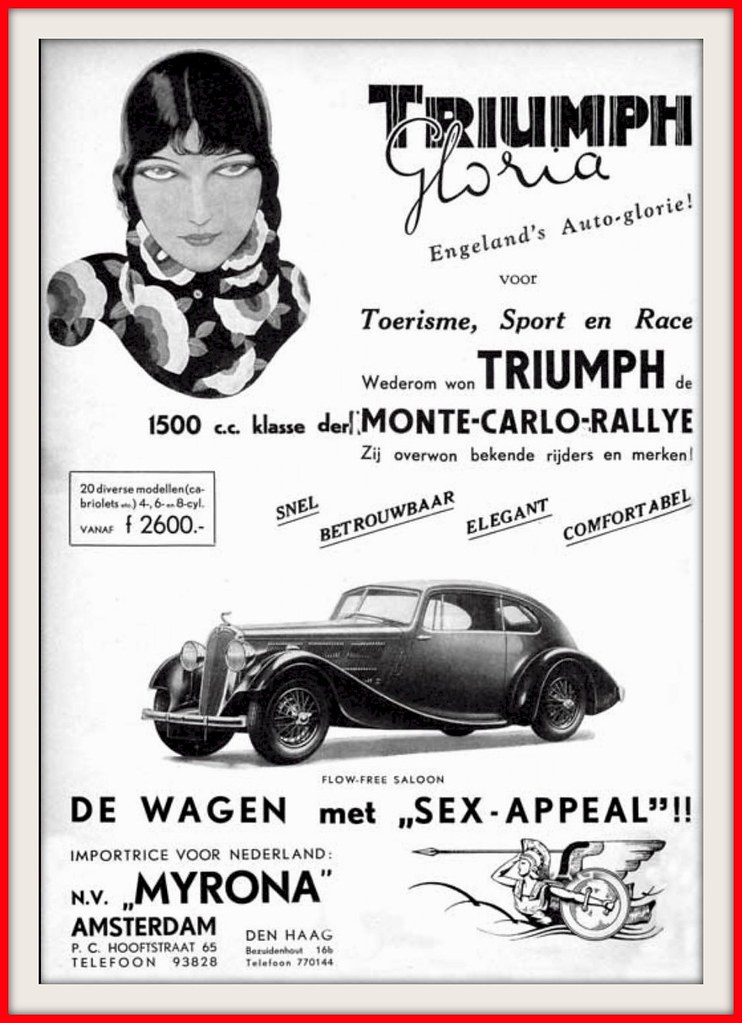#spanish netherlandish
Text

Anthony van Dyck (Flemish/Spanish Netherlands, 1599-1641)
Princess Mary, Daughter of Charles I of England, ca.1637
Museum of Fine Arts Boston
#Anthony van Dyck#flemish#spanish netherlandish#1600s#art#royal#princess#fine art#european art#classical art#female portrait#female#portrait#portrait of a girl#Princess Mary#english princess#house of tudor#european history#europe#european#oil painting#fine arts#europa#island kingdom#england
62 notes
·
View notes
Text
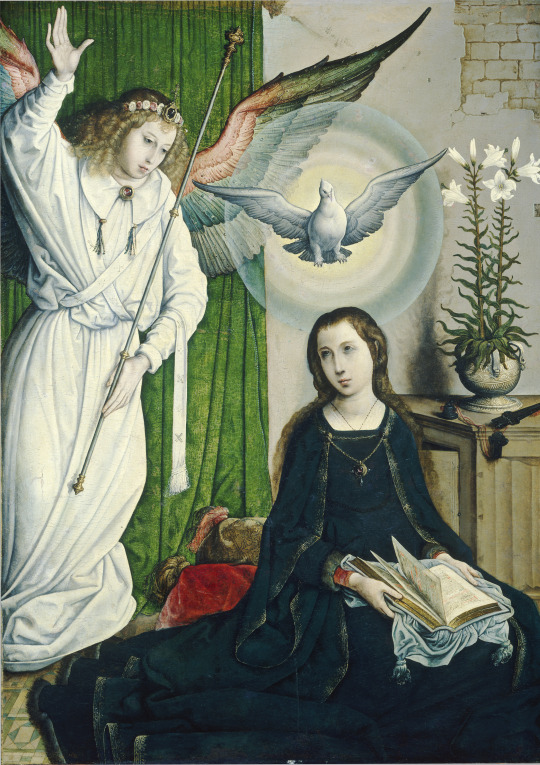
The Annunciation, Juan de Flandes (1450-1519)
#Advent#Annunciation#art#art history#Juan de Flandes#religious art#Biblical art#Christian art#Christianity#New Testament#Gospels#Early Netherlandish#Flemish art#Spanish-Flemish art#Northern Renaissance#16th century art#oil on panel#National Gallery of Art
376 notes
·
View notes
Text
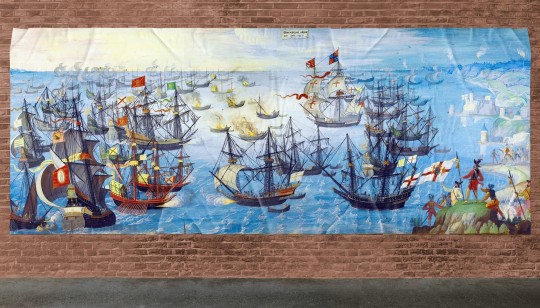
Monogrammist, The Spanish Armada Off The South Coast Of England
#Monogrammist#powerpoint slides#anonymous Netherlandish painter#Pieter Bruegel the Elder#Spanish armada
0 notes
Note
Why do you think the portrait of Catherine/Mary has a K (in the necklace) AND a C (on the bodice)? It's my last real sticking point in the identity debate, especially after you pointed out the pomegranate sepals. (According to the Mary theorists, the C stands for Castile, and the K for Karolus, to signify her betrothal to Charles V)
You pretty much summerized it. I don't think I can add that much.
Jewelry with initials refering to either person's name, their title or their spouse was very popular at the time.
In Catherine's case:
K for Katherine
C for Catalina(her name in Spanish, and potentially it being smaller than K, signalling she is looking forward to her life in England, is more accepting of English ways while her spanish roots are not forgotten, but are bit smaller now...)
or pottentially for Castile (her mother's realm)-not that likely.
In Mary's case:
K for Karolus(latin version of Charles)-for Mary's bethrohed
C for Castile (whom Charles was heir to)
Mary was for long while bethrohed(and married to proxy) to Catherine's nephew who was later Holy Roman Emperor(Charles V). He was heir of his mother Joanna I of Castile, and thus Mary as Charles's bethrohed was styled as Princess of Castile.
(Why not princess of Spain? King Ferdinand of Aragon was alive...thus charles was heir of just Castile at the moment, his mother was heir of Aragon...)
Thus initials would fit both women.
I have to additionally point out that according to Dr Kemperdick the C-initial is not C but E.
Those letters used to look alike and you could confuse them:

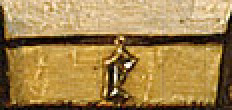
Dr Kemperdick seems like credible source for me, and probably have been involved in exhbition of Sittow's work he later wrote review about ...could have seen it in person and would have certainly have way more experience of reading out weirdly shaped letters in paintings than I do...so I believe might be an E-initial.
Potentially an alteration or minor damage crucial spot within that letter could make it seem as one or other letter. So I am not really sure which one is it.
But even if it was E-initial it fits both women.
E-for Elizabeth. -For their mothers. Isabella and Elizabeth are same name in just different language.
And since Katherine wrote her name with K and not C, it's possible she'd also use her mother's initial with E, instead of I.
For example Elizabeth I wore B-necklace. We have only few historical examples of people wearing their parents initial, it certainly wasn't very common. So i think it unlikely
Update: i was told this is photoshopped, so no example of Elizabeth wearing B necklace:

(I am already checking credibility photos way more than other people. Give me a break.)
Also E for England or E for España (Spain-thanks Isadomna) would be a very logical choice and it's possible that it was used because it could refer to both.
Hence initials fit both women, but actually they are also used as basis for third theory of who it is-Isabella of Castile.
(idealized and portrayed as much younger than Sittow could have met her)
With K and C both standing for Castile(in some languages it is written with K) . And idk why one would not use same letter in both cases! But E for España could be...
But tbh the theory is kind of ridiculous. Painted younger, ...ok? But wrong features and fashion of diffrent country when Sittow met her and could have drawn her from life?-Ridiculous!
Tbh if you wish to go for theory initials fit other women in Catherine's family-go for Joanna!
K-for Karolus(Charles) her eldest son
C-for Castile
or E for España
+she is married to Netherlands, thus why couldn't she wear Netherlandish outfit?
(Features would be wrong again, but you know initials would work out.)
Thus my conclusion is that you cannot solve the mystery based upon initials. One has to rely on symbolism of other details within the painting and dating of the outfit. And if anybody believes it is same thing Catherine's nieces are wearing in 1510s-they need to have their eyes checked...it's similiar, but certainly not same, diverging quite a bit..(thus more than few years difference.)
I think several of my past posts would be interesting for you if you're intrested in Catherine of Aragon vs Mary Rose debate:
Real looks of Catherine of Aragon-Part 1
Real looks of Catherine of Aragon-Part 2: Why Mr Matthews should have never been believed
(Mr Mathews is guy who came up with Mary Rose nonsense.)
Scallops as symbol
or in debate of which paintings are c.1514 paintings of Mary Rose Tudor as Princess of Castile:
Is this woman Isabella I of Castile or Mary Rose Tudor, Queen of France?-part 1
Isabella I vs Mary Rose Tudor:part 2- Could it actually be Juana?
and relating to this:
Sisters in law 1: Mary Rose Tudor, Queen of France-depictions and hair colour:Part 1
Sisters in law 1: Mary Rose Tudor, Queen of France-depictions:Part 2
This is not Catherine Willougby!
(yes, that is a name of post.)
additional posts regarding debate of Mary Rose vs Queen Isabella:
Her family Part 2-Isabella I of Castile-paintings, iluminations, stonework
Her family Part 3-Juana I’s depictions
...Write to me if you have any aditional questions.
23 notes
·
View notes
Text

Unknown Artist, 'Portrait of an Old Woman', oil on canvas, no date (17th century), Dutch (Southern Netherlands), currently in the collection of the Louvre, Paris, France.
The former owner who donated the piece to the Louvre, Dr. Louis la Caze (b.1798 - d.1869), was enamoured with the work, and purchased it as a piece in the school of Velasquez from Spain. He believed the work was not Spanish in origin and spent many years seeking alternative attributions; which appear to be confirmed now by the Louvre's current attribution to the Southern Netherlandish school. (x)
#unknown artist#unknown sitter#oil on canvas#1600s#dutch#southern netherlands#louvre#paris#diego velasquez#spanish#spain
21 notes
·
View notes
Photo

Antonio de Pereda
Allegory of Vanity (1632 - 1636)
Oil on canvas, 139.5 x 174 cm
Kunsthistorisches Museum, Vienna
Highlights from around the web 💫
✨ Antonio de Pereda y Salgado (c. 1611 – January 30, 1678) was a Spanish Baroque-era painter, best known for his still lifes. [1]
✨ Pereda was born in Valladolid, Spain, the eldest of three brothers from an artistic family. His father, mother and two brothers were all painters. [2]
✨ We know little about the career of Antonio de Pereda, apart from the fact that he received his training in Madrid. The dear influence of Netherlandish painting is characteristic of his work, and this is particularly true of the present Allegory. It occupies a special place in the art of Madrid, because with it Pereda introduced to Spanish painting motifs of vanity symbolism long established in Netherlandish art. [3]
↪ Get this design on a t-shirt, sweatshirt, or notebook 🥀
#antonio de pereda#allegory of vanity#spanish art#allegory#vanitas#oil painting#art history#dark academia#dark academia aesthetic#light academia#light academia aesthetic#academia aesthetic#archive aesthetic#back to school#art major#curators on tumblr
4 notes
·
View notes
Text

I'm surprised I haven't posted this captivating portrait before. It is of the Queen of England, Elizabeth I, as a princess. I've been reading about her life recently and it is crystal clear why she chose never to marry, relinquish her power to a man, or to have children. She was not yet three years old when her mother, Anne Boleyn, was executed on her father's orders, based upon unproven allegations of adultery and treason; nearly four when her step-mother, Jane Seymour, died following childbirth; eight years old when another step-mother, Katherine Howard, was executed, again upon the orders of her father; and fourteen when her last step-mother, Catherine Parr, died from complications related to childbirth. She also witnessed a loveless marriage between her half-sister, Mary I, and her Spanish husband, Philip II.
The artist of the painting is presumed to be Netherlandish painter, William Scrots and dates between 1546 and 1547, so Elizabeth would have been thirteen or fourteen years old. It is believed to have been commissioned by her father, Henry VIII. He died on 28th January 1547, so I wonder if he ever got to see it completed.
The colours, especially the red, may appear slightly more saturated and vivid in this reproduction than the genuine article, (I don't know) but never mind!
0 notes
Text
https://warfarehistorynetwork.com/article/dorylaeum-the-first-christian-muslim-clash-of-the-crusades/
https://commons.wikimedia.org/wiki/File:Philpot,_Glyn_Warren;_Richard_I_Leaving_England_for_the_Crusades,_1189;_Parliamentary_Art_Collection.jpg
https://www.medieval.eu/the-last-crusade-1270/
https://www.britannica.com/event/Crusades
https://www.historytoday.com/archive/crusades/saladins-triumph-battle-hattin-1187
https://www.historytoday.com/archive/travels-through-time-crusadeshttps://www.faganarms.com/products/spanish-officer-s-sword-m-1861?_pos=453&_sid=b54494f84&_ss=r
https://www.faganarms.com/products/spanish-officer-s-sword-m-1861?_pos=453&_sid=b54494f84&_ss=r
https://arkstainedglass.co.uk/portfolio/st-marys-church-southampton-titanic-crew-memorial/
https://www.dominicwinter.co.uk/Auction/Lot/288-powell-james--sons-original-designs-for-stained-glass-whitefriars-glass-works/?lot=325147&sd=1
https://www.stainedglassinc.com/window/1018-jesus-resurrection/
https://depositphotos.com/vector/realistic-gothic-medieval-contour-window-gate-arch-background-texture-architectural-213410626.html
https://www.researchgate.net/figure/Evolution-of-Gothic-window-tracery-Early-period-a-b-High-Gothic-c-d-late-period_fig1_4082588
https://en.wikipedia.org/wiki/Tracery
https://www.tumblr.com/illustratus/689874183830880256/the-accolade-by-edmund-blair-leighton?source=share
https://www.abelard.org/france/stone-tracery-in-cathedrals.php
https://www.htss.org.uk/future.php
https://www.researchgate.net/figure/a-The-execution-of-gothic-window-yields-eight-polygons-on-the-stack-defining-the_fig5_4082588
https://www.tumblr.com/ancient-hoe/675468906911105024/art-by-nicola-samori?source=share
https://eileentully.com/2021/03/19/the-fifth-sword-of-sorrow-standing-near-the-foot-of-jesus-cross/
https://www.tumblr.com/illustratus/714062878983028736/detail-of-the-statue-of-italian-condottiero?source=share
https://fineartamerica.com/art/tomb+of+christ?page=2
https://www.tumblr.com/fhtagn-and-tentacles/691250086558285824/churchy-weirdos-by-kenneth-scott?source=share
https://www.alamy.com/design-for-a-knife-handle-with-a-scene-from-the-book-of-tobit-15801600-johann-theodor-de-bry-netherlandish-design-for-a-knife-handle-with-a-scenes-from-the-book-of-tobit-in-an-oval-at-center-showing-two-kneeling-figures-before-a-canopied-bed-in-an-interior-on-a-blackwork-background-with-grotesques-including-two-winged-mermaids-at-bottom-flanking-the-central-design-biblical-texts-on-blades-with-alternate-finials-above-from-a-series-of-twelve-plates-design-for-a-knife-handle-with-a-scene-from-the-book-of-tobit-424958-image458498397.html
https://www.metmuseum.org/art/collection/search/425051
0 notes
Video
Triumph Gloria Very Fast - Elegant - The Wagen with Sex Appeal by carlylehold

Blanco y Negro, Face Powder Trini, 1927. Illustration possibly by Federico Ribas.
15 notes
·
View notes
Note
Thoughts on spain?



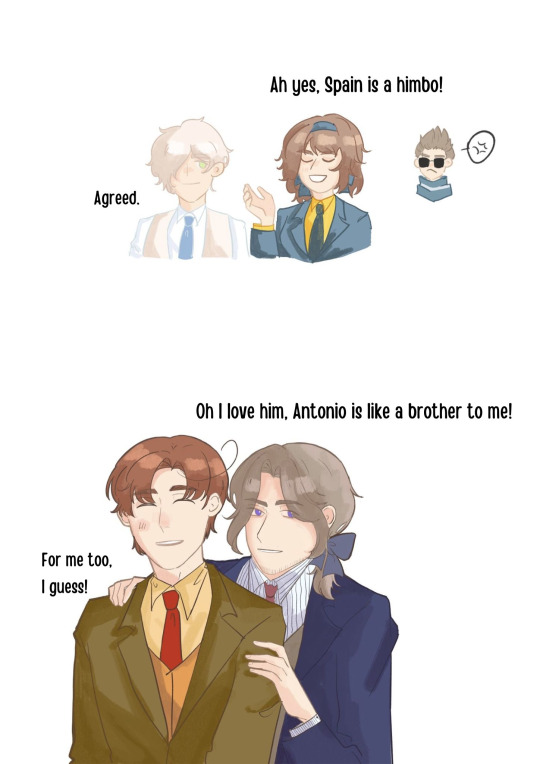

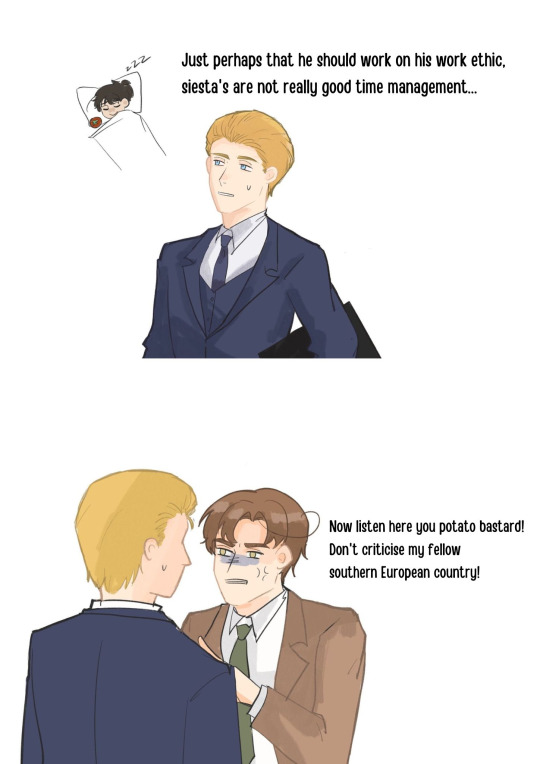

Some historical explanations below the cut.
Obviously the countries that were under Spanish reign, aka the tomato gang, have mixed feelings about Spain. The kind of rule wasn't always as nice as Hetalia likes show, which is normal really... Imagine Hetalia talking about religious persecution ahahaha.
Anyway, under Spanish rule Belgium and the Netherlands formed the low countries together. Then there was Philip the second's stern Counter-Reformation measures which sparked the Dutch Revolt in the mainly Calvinist Netherlandish provinces, which led to the outbreak of the Eighty Years' War. This was “solved” after the fall of Antwerps (Belgium) after which there was the idea that all provinces that wished to remain Catholic would remain under Spanish rule and all the rest could go on and form the Netherlands.
All the protestants moved from Catholic Belgium, which remained under Spanish rule for quite a while, to Amsterdam. Making Amsterdam one of the richest if not the richest port in Europe.
I think the reason we (as this is Belgian mun speaking) aren't as upset with the Spanish is because we had a certain level of autonomy still... We also became filthy rich, had a huge cultural boom with lots of Flemish painters and traders and Brussels had become very prosperous, being the capital of the Spanish lowlands. So life was pretty good and thus no hard feelings towards Spain.
So if you want to translate that into Hetalia just imagine Spain kicking the Netherlands out to become Belgium's sugar daddy. Is this problematic to say? lmao I don't know. historians send me anon hate if you wish. Luxembourg was still part of Belgium at that point, so he benefitted in similar ways. This implies that Spain was Luxembourg’s sugar daddy as well, I guess.... As long as they were nice and remained Catholic? I’m trying to see how much weird things I can say before I get some anons complaining about it. it will give me the satisfaction of knowing this is being read :)
Anyway
Now South Italy was also under Spanish rule. The problem with Italy is that the idea of “Italy” itself is a fairly new concept. For the sake of Hetalia let’s assume we’re just talking about Romano. His issues with Spain would be similar to the Netherlands. Accusing Spain of an authoritarianism, being closed to new ideas and innovation and of promoting spagnolismo, an exaggerated and ostentatious pomp, all perceived as the fruits of a decadent, backward-looking colonial domination. Spanish rule has apparently benefitted Italian peace and security to some extend but it has also been the main causes of crisis in 17th-century Italy.
In modern times there are closely converging views on European issues. As their PM said only a couple of weeks ago:
"There is a strong harmony between Spain and Italy when it comes to the idea of a united European response to the crises we face,Our bilateral cooperation can turn into a motor that will drive Europe forward."
So yes, nowadays the relations between the two are good, Italians like to go on holiday in Spain because the cultures are similar and the cuisine is good which is why Italy reacted the way he did and why Romano defended him faced against a “Northern European” ;)
Franco-Spanish relations are described as following: Relations between Spain and France are those of competing neighbours but at the same time they usually act as partners and complement one another in any initiative involving both countries. The two countries share a long history of economic, trading, cultural and political links. The french ministry of foreign affairs has more info X
Then lastly, I had to rack my brain for something to say about the Spanish German relationship. Didn’t find much, and it’s because of the following: “Historically and culturally Spaniards at least don't have any significant hate or even rivalry towards Germans. Spain is Latin Mediterranean western European and Germany is Germanic northern central European so there are cultural differences… but there's no cultural rivalry or hate because historically Spain and Germany have been allies in virtually every major conflict.
Obviously German tourists love Spain, second largest group of tourists after the Brits, you can spot them from far away with the sunburns and the socks and sandals.
Politically the German ministry of foreign affairs (X) says the following:
“ Relations between Germany and Spain are close and friendly.“
Very German. To the point. What more do you want?
Thank you for the ask!
#hws spain#aph spain#antonio carriedo#Hetalia EU#hws france#hws belgium#hws Luxembourg#hws Netherlands#hws Germany#hws South Italy#hws Italy#historical hetalia
171 notes
·
View notes
Photo

A picture that has been lying unseen in the vaults of the National Gallery for decades could be an extremely rare portrait of Queen Isabella of Spain, arguably Europe’s first great queen.
The Magdalen (after Mary Magdalene) is being claimed by both a leading art expert and an author of a new biography of the queen to be Isabella of Castile, who married Ferdinand of Aragon in 1469.
Pedro Flor, professor of art at the New University of Lisbon, believes the portrait was painted by the Estonian-born artist Michael Sittow, who worked at the court of Isabella. Sittow painted several important Catholic women, some dressed like Mary Magdalene, including Catherine of Aragon, Isabella’s daughter and mother of Mary I of England.
The jewellery in the National Gallery portrait is identical to that worn by the queen, as is the heavy chain with her personal symbol of a bundle of arrows, which Flor discovered on medallions in Brussels and Madrid.
Her looks, as well as the colour of her eyes and hair, are virtually the same as in the two accepted single portraits of Isabella, which are in Spain.
The thesis is supported by Giles Tremlett, a Madrid-based journalist, whose biography of Isabella of Castile is published this week. ‘She was a quite extraordinary woman — a young female leader in a man’s world,’ he said.
The National Gallery said: ‘We call her The Magdalen, and as we have no name for the artist, we just say it is Netherlandish. However, as we don’t yet have a new catalogue of our Spanish and Portuguese paintings, we are unable to offer further information on the sitter. However, it would not have been unusual for a sitter in a Renaissance portrait to be represented as a religious figure.’
(x)
77 notes
·
View notes
Text

Juan de las Roelas (Spanish/Netherlandish, c.1558-1625)
Santa Ana enseñando a leer a la Virgen, ca.1610
Museo Bellas Artes De Sevilla
#juan de las roelas#1500s#1600s#spanish art#european art#hispanic#christian art#art#fine art#classical art#europe#european#netherlandish#oil painting#fine arts#europa#mediterranean#angel#angels#painting#medieval europe
95 notes
·
View notes
Text
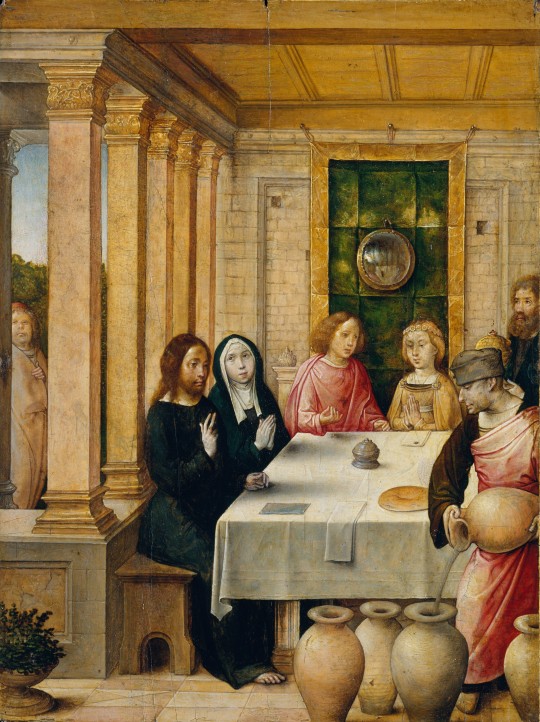
The Marriage Feast at Cana, Juan de Flandes, 1500
#art#art history#Juan de Flandes#religious art#Biblical art#Christian art#Christianity#New Testament#Gospels#Wedding at Cana#Flemish art#Early Netherlandish#Early Netherlandish art#Spanish Renaissance#Flemish-Spanish art#15th century art#Metropolitan Museum of Art#oil on panel
143 notes
·
View notes
Text
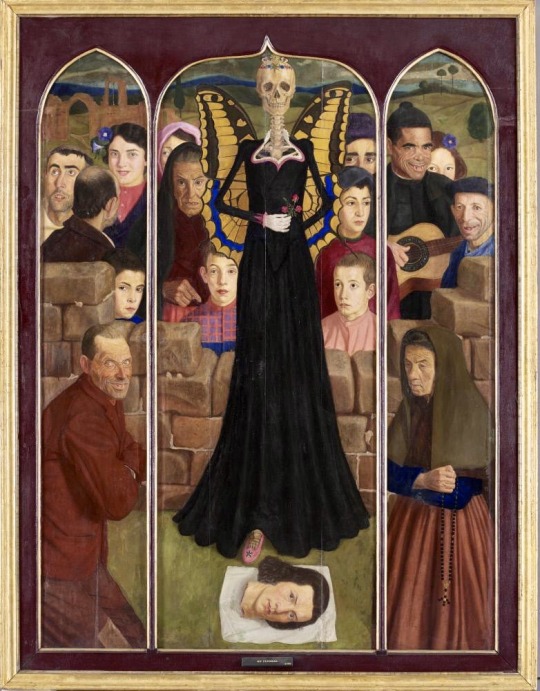
Miguel Viladrich Vilá (Torrelameu, Lérida/Lleida 1887 – 1956 Buenos Aires)
My Funeral / Mis funerales (Mis funerailles), 1910
Oil on wood / Óleo sobre tabla, 176 x 133 cm
Signed and dated on the wall in the central panel / Firmado y fechado sobre la pared en la tabla central: “M. Viladrich MCMX”
Inscribed on the back / inscrito en el reverso: “Mis funerailles Viladrich [thumbprint of the artist / huella del pulgar del artista]”
New York, The Hispanic Society of America, A1983
PROVENANCE: Miguel Viladrich Vilá; acquired by Archer Huntington for The Hispanic Society, 1927.
Miguel Viladrich Vilá was born at Torrelameu north of Lérida (Lleida), the son of a local doctor. He studied architecture at Barcelona, 1905-06, before deciding to become a painter. Essentially self-taught, he traveled to Madrid, Zaragoza, Paris, and Rome, copying works at the Prado and other museums. From 1909 to 1914, Viladrich was based in Paris, although he often returned to Lérida, as in 1910. In 1914, with the coming of World War I, Viladrich moved to Fraga, just across the frontier with Aragón just southwest of Lérida. He established himself in a ruined castle, which he set about restoring and christened “el Castillo de Urganda la Desconocida,” after the enchantress in Cervantes’ Don Quixote. In 1926, after an exhibition of his work in Buenos Aires, he came to New York, hoping that Archer Huntington would offer him an exhibition; instead, Huntington bought all 34 works in Viladrich’s possession, essentially his entire production through 1926. Viladrich received monumental commissions in the early 1930s, such as the large mural, Barcelona Cap i Casal de Catalunya, for the Escala Negra at the Casa de la Ciudad de Barcelona (ca. 1930), and also traveled to Morocco in 1932, where he produced a series of rich portraits. Viladrich and his family were active supporters of the Republican side in the Spanish civil war – one of his sons was killed in the conflict – and he emigrated to Buenos Aires in 1939, where he died there in 1956.
Viladrich is difficult to assign to any one artistic movement, although two traditions suggest themselves. The first being the late nineteenth-century movements that sought both purity in art and a return to early Renaissance models, what was called “primitive” art.. This tradition had begun with the mostly German group of artists in the Nazarene circle in Italy during the early nineteenth century and was available to Viladrich via the traditions of the Catalan followers of the Nazarenes in the Cercle de Sant Lluc and its descendants in Barcelona. By 1900, this point of view had come to be linked to the general cultural concerns of the Generation of ’98. In Priscilla Muller’s formulation, Viladrich’s “uniquely archaistic painting, which would ever seem aberrant, was deliberately self-created and personal. While invoking the past, he directed his vision to portraying Spain’s steadfast people, its locales and produce as he knew them.” The second tradition is international Symbolism, clearly apparent in a picture such as My Funeral.
My Funeral was first exhibited at the Exposición Nacional in Madrid in 1910. Its triptych form with a purple Gothic masking frame provide the archaism; a clear reference to early Netherlandish triptychs with donor figures, and the simple style of depicting the figures in a bright but ambient light, similar to the quattrocento Renaissance portraits of Antonio Pollaiuolo (1431/32-1498), Piero della Francesca (h. 1415-1492), and Domenico Ghirlandaio (1449-1494). The elegantly dressed figure of death and the severed head of the artist on the white handkerchief provide the symbolism, at once referring to an artistic tradition going back to Caravaggio (1571-1610; David with the Head of Goliath) and other Baroque artists, and possibly the Christian tradition of the white cloth under the host on an altar.
Hispanic Society of America
15 notes
·
View notes
Text
St. Barbara by Lucas Cranach the Elder
Lucas Cranach the Elder is not among painters we associate with Netherlandish art. However, he made the trip in 1509, and painted Emperor Maxmilian and future Charles V during the occasion.

While we have no prove he painted also netherlandish royal ladies, it is clear they inspired the St. Barbara(above) which he painted around same time. C.1509-it is excellent example of netherlandish fashion from that time...and very suitable as costume inspiration. Except the halo of course. :-)
It's quite rare we can tie painting to specific year, but that makes it even more valuable in terms of creating chronology of fashion for specific country. And I am very gleeful that this fits to my chronology- late 1500s/very early 1510s.
The saint Barbara in this golden outfit is left wing of portable artalpierce(triptych) belonging to Landgrave Wilhel of Hesse an Anna of Mecklenburg.
Which is also called-Jesus flanked with Saints Barbara,left and Catherine,right,1509 Lucas Cranach:

If you want to see the painting in more detail, here is the link:
PS: I forgot to say that this stripy embroidery is reminisense of spanish embroidery(examples more bellow)
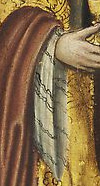
(Update-i have no idea why this image shows so large. The picture i put in is no larger than my thumb. It's probably some glitch. Sorry.)
and thus probably brought into Netherlands by Joanna I of Castile or Margaret of Austria's time in Spain as Princess of Austurias(both happening in late 1490s). I don't recall another example of this, in netherlandish fashion, so far.


But I'd expect that at court it could have lingered for bit, especially among royals women. Margaret and Joanna's daughters.
7 notes
·
View notes
Text
“Doubtless many reigns have begun amidst an atmosphere of jubilant expectation; but this beginning had an especial lustre. For the new king, accession to the throne brought deliverance from a long, probably oppressive subjection to a stern father and grandmother, and released him into the bright, cloudless warmth of gaiety, freedom and power. He stood now on the brink of manhood, suddenly clad with the full panoply of kingship. He ascended a throne which his father had made remarkably secure, he inherited a fortune which probably no English king had ever been bequeathed, he came to a kingdom which was the best governed and most obedient in Christendom. Shortly before his death, his father had granted a general pardon to his people. The new king confirmed this - in ampler form.
His father left him a body of accomplished ministers, most of whom would continue to serve him. But those two men, Richard Empson and Edmund Dudley, who had served Henry VII's money-gathering and law-enforcement so assiduously, and whose 'unreasonable and extort doing noble men grudged, mean men kicked, poor men lamented, preachers openly at Paul's Cross and other places exclaimed, rebuked and detested' - these would be cast aside. Within a few hours of his accession Henry had been so roused to wrath by tales of their wrong-doing that, even as he came to the Tower amidst the trumpets and rejoicing on that 23 April, the second day of his reign, they were seized and brought thither as prisoners, where they languished until their execution sixteen months later.
'Heaven and earth rejoices; everything is full of milk and honey and nectar. Avarice has fled the country. Our king is not after gold, or gems, or precious metals, but virtue, glory, immortality.' So wrote Lord Mountjoy to Erasmus in a celebrated, and, as it proved, somewhat inaccurate, outburst of enthusiasm. There had come to the throne the very perfection of Christian kingship - gracious, gifted and enlightened - and with his coming, it seemed, bleak days must give way to bounteous prosperity. The new king quickly married; and, after all, he married Catherine. He himself said that he did so in obedience to his father's dying wish, but it may well be that his story of Henry VII's deathbed change of heart was invented shortly afterwards to placate the Habsburgs whose daughter, Eleanor, had just been jilted.
Fuensalida believed that it was the young king himself who brought about the change of plan, and this may be the truth. Five days after Henry VII died, the ambassador was still convinced that Catherine's cause was lost and quoted two members of the Council to the effect that the dying king had assured his son that he was free to marry whomsoever he chose. Then the situation changed radically. Fuensalida was suddenly called before the Council and, to his astonishment, not only assured of the king's fervent goodwill towards the princess, but told by the bishop of Durham, Thomas Ruthal, who had at that moment emerged from a meeting with Henry in a nearby room, that such matters as Catherine's dowry were trifles and that the king looked to him to settle quickly all the details concerning the marriage; whereupon he withdrew in some bewilderment and set about recovering the possessions of the princess which he had already begun to transfer to Bruges.'
Six weeks later, on 11 June, the marriage between Henry and Catherine was solemnized in the Franciscan church at Greenwich. A little while before there had been some talk of a possible scruple about his marrying his dead brother's widow, and many years later Bishop Fox recalled that the archbishop of Canterbury, William Warham, had disapproved of the union, apparently because he doubted the sufficiency or validity of the now six year-old bull of dispensation - though on what ground he did so we are not told. Warham's qualms were to be of consequence nearly two decades hence when the lawfulness of this marriage became a matter of impassioned debate; but for the moment any doubts there may have been were brushed aside as a proud king undid the protest he had made at his father's command three years before and finally (and freely) ratified his union with a princess who, though five years his senior, was probably still beautiful and certainly of a quality of mind and life which few queens have seriously rivalled.
At least outwardly, her husband was, and had been since childhood, immensely striking. Ten years before, Erasmus had strolled over to Eltham in the company of Thomas More to meet the royal children and been much impressed by the grace and poise of the eight year-old Duke Henry. By the time he came to the throne he had burgeoned into a full-blooded seventeen year-old, upon whom Nature had showered apparently every gift. 'His majesty', wrote a dazzled Venetian shortly after the new reign began, 'is the handsomest potentate I ever set eyes on.' He was tall and splendidly built, with glowing auburn hair 'combed short and straight in the French fashion' and a pink round face so delicately cut 'that it would become a pretty woman'.'
He was 'extremely handsome. Nature could not have done more for him,' one said a few years later, in 1519. 'He is much handsomer than any sovereign in Christendom; a great deal handsomer than the king of France, very fair and his whole frame admirably proportioned.' His was a superlative body. He was a capital horseman who could stay in the saddle for hour after hour and tire out eight or ten horses; he exulted in hawking, wrestling and dancing; he excelled at tennis, 'at which game it is the prettiest thing in the world to see him play, his fair skin glowing through a shirt of the finest texture'. He could throw a twelve-foot spear many yards, withstand all-comers in mock combat with heavy, two-handed swords, draw the bow with greater strength than any man in England.
In July 1513, while at Calais on his first campaign, he practised archery with the archers of his guard and 'cleft the mark in the middle and surpassed them all, as he surpasses them in stature and personal graces'. Above all, he delighted in prowess in the ring and at the barrier, the sovereign sport of princes. Through the summer of 1508 the prince of Wales, still only just seventeen, had hurled his keen, tireless body into the fury of the tournament and excelled all his opponents, and his accession to the throne would inaugurate a festival of apparently endless jousting and tilting, at which the king ever carried away the prizes.
When Erasmus first met him on that day in 1499 - standing with his sisters Margaret and Mary and his infant brother Edmund, soon to die - he 'sent me a little note, while we were at dinner, to challenge something from my pen'; whereupon Erasmus, unable to perform extempore, spent three anxious days composing an ode entitled 'A Description of Britain, King Henry VII and the King's Children' and a eulogy of Skelton (who had doubtless been the true author of the boy's message), to which he added some odds and ends scraped together from the bottom of his trunk to form a literary nosegay worthy of the young duke.'
Seven years later Erasmus wrote to Henry and received so accomplished a reply that he was convinced that someone else had had a large hand in its composition. But Lord Mountjoy, his patient patron, showed him a number of letters from the prince to various people in which there were so many signs of corrections and additions that Erasmus was forced to abandon his scepticism. Presumably Skelton and Hone pushed Henry's pen to paper, for in later life Henry was never an industrious letter-writer - except during those months twenty years or so later when romantic passion got the better of sluggishness and drew from him some rather heavy sighings for his absent beloved, Anne Boleyn. But Henry was undoubtedly a precocious, nimble-minded pupil.
He knew Latin and French and some Italian. He is said to have acquired some Spanish, and about 1519 had a sufficient (if passing) interest in Greek to receive instruction in this fashionable language from Richard Croke, a minor English humanist who had hitherto been at Paris, Louvain, Cologne and Leipzig, and was now to teach at Cambridge. His grasp of theology may have been less assured than he supposed, but it was remarkable for a king; he showed himself an apt student of mathematics; and it was his custom to take Thomas More 'into his private room, and there some time in matters of astronomy, geometry, divinity and such other faculties, and some time in his worldly affairs, to sit and confer with him, and other whiles would he in the night have him up into the leads [i.e. the roof] there to consider with him the diversities, courses, motions and operations of the stars and planets'.
Above all he was a gifted, enthusiastic musician. He had music wherever he went, on progress, on campaign. He scoured England for singing boys and men for the chapels royal, and even stole talent from Wolsey's choir, of which he was evidently jealous. Sacred music in the Renaissance style - the work of Benedict de Opitiis and Richard Sampson, later bishop of Chichester - was introduced into the royal chapel in 1516 and sung by a choir judged by an Italian visitor to be 'more divine than human'; and between 1518 and 1528 the king acquired a collection of French and Netherlandish music. Henry had many foreign musicians at court, like the violist Ambrose Lupo, the lutenist Philip van Wilder from the Netherlands, as well as trumpeters, flautists and two Italian organists, de Opitiis and the famous Dionisio Memo, organist of St Mark's, Venice, who was lured to England in 1516 and would sometimes perform for four hours at a stretch before the king and court.
There were twenty-six lutes in Henry's collection of instruments, together with trumpets, viols, rebecs, sackbuts, fifes and drums, harpsichords and organs. The king himself played the lute well; he could manage the organ and was skilled on the virginals (which perhaps John Heywood, his virginalist, taught him). He had a strong, sure voice, could sight-read easily, and delighted to sing with a courtier like Sir Peter Carew 'certain songs they called "freeman's songs", as "By the banks as I lay" and "As I walked the wood so wild" '. His court was a generous patron to composers, headed by the great Dr Fairfax, if not Henry himself - for the king wrote at least two five-part Masses, a motet, a large number of instrumental pieces, part songs and rounds. 'Pastime with good company', 'Helas, madam' and perhaps 'Gentle prince' are his work; so too the motet 'O Lord, the maker of all thing' - no mean achievement for a monarch.
Henry has traditional.ly been seen, alongside James IV of Scotland or the colourful, versatile Emperor Maximilian I, as the archetype of resplendent Renaissance monarchy; and the praise which Erasmus and other humanists heaped upon the zeal for learning and the arts of this king who had been so generously endowed in mind and body seemed to justify this picture of him. But, though Erasmus could speak stern words about monarchy and wealth, he was a shameless flatterer of kings and the wealthy, and we should treat his outpourings with caution. If anything, Henry was the last of the troubadours and the heir of Burgundian chivalry: a youth wholly absorbed in dance and song, courtly love and knight-errantry.
He was to grow into a rumbustious, noisy, unbuttoned, prodigal man - the 'bluff king Hal' of legend - exulting in his magnificent physique, boisterous animal exercise, orgies of gambling and eating, lavish clothes. 'His fingers were one mass of jewelled rings and around his neck he wore a gold collar from which hung a diamond as big as a walnut', wrote the Venetian ambassador, Giustinian, of him. He loved to dress up and his wardrobe, ablaze with jewels of all description and cloth of gold, rich silks, sarcenets, satins and highly-coloured feathers, constantly astounded beholders. He was a man who lived with huge, extroverted ebullience, at least in the earlier part of his life, revelling in spectacular living, throwing away money amidst his courtiers on cards, tennis and dicing, dazzling his kingdom.
Many readers will have their chosen picture of him - Henry, cock-sure and truculent, astride one of Holbein's canvases; Henry, dressed in dazzling richness and with a huge gold whistle, crusted with jewels, hanging from a gold chain, dining with his queen aboard Henry Grace a Dieu on the occasion of its launching; Henry walking up and down More's garden at Chelsea for an hour with his arm round More's neck;' Henry showing the Venetian ambassador his fine calf and demanding to know whether it was not a finer one than the French king boasted; Henry, at Hunsdon, over twenty years later, holding his precious son Edward in his arms and bringing him proudly to a window 'to the sight and great comfort of all the people'.
He was a formidable, captivating man who wore regality with splendid conviction. But easily and unpredictably his great charm could turn into anger and shouting. When (as was alleged) he hit Thomas Cromwell round the head and swore at him, or addressed a lord chancellor (Wriothesley) as 'my pig',' his mood may have been amiable enough, but More knew that the master who put his arm lovingly round his neck would have his head if it 'could win him a castle in France'. He was highly-strung and unstable; hypochondriac and possessed of a strong streak of cruelty. Possibly he had an Oedipus complex: and possibly from this derived a desire for, yet horror of, incest, which may have shaped some of his sexual life.”
- J.J. Scarisbrick, “The New King.” in Henry VIII
#henry viii of england#tudor#history#j.j. scarisbrick#jj just had to throw that freudian psych in there
11 notes
·
View notes
